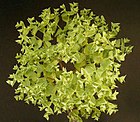Note: This is a project under development. The articles on this wiki are just being initiated and broadly incomplete. You can Help creating new pages.
Euphorbia peplus - Devil's milk
Euphorbia peplus is a species of Euphorbia. It is native to most of Europe, northern Africa, and western Asia, where it typically grows in cultivated arable land, gardens and other disturbed land. Outside of its native range it is very widely naturalised and often invasive, including in Australia, New Zealand, North America, and other countries in temperate and sub-tropical regions.
Contents
[hide]- 1 Uses
- 2 Parts Used
- 3 Chemical Composition
- 4 Common names
- 5 Properties
- 6 Habit
- 7 Identification
- 8 List of Ayurvedic medicine in which the herb is used
- 9 Where to get the saplings
- 10 Mode of Propagation
- 11 How to plant/cultivate
- 12 Commonly seen growing in areas
- 13 Photo Gallery
- 14 References
- 15 External Links
Uses
Leukemia, Skin Cancer, Actinic Keratosis, Dysentery, Skin eruptions, Blood pressure.
Parts Used
Chemical Composition
Contains volatile oils, flavonoids, apigenin, luteolin, quercetin, kaempferol, tiliroside, triterpene glycosides including euscapic acid and tormentic acid, phenolic acids, and 3%–21% tannins.[1]
Common names
| Language | Common name |
|---|---|
| Kannada | |
| Hindi | |
| Malayalam | |
| Tamil | |
| Telugu | |
| Marathi | NA |
| Gujarathi | NA |
| Punjabi | NA |
| Kashmiri | NA |
| Sanskrit | |
| English | Radium Weed, Petty spurge |
Properties
Reference: Dravya - Substance, Rasa - Taste, Guna - Qualities, Veerya - Potency, Vipaka - Post-digesion effect, Karma - Pharmacological activity, Prabhava - Therepeutics.
Dravya
Rasa
Guna
Veerya
Vipaka
Karma
Prabhava
Habit
Identification
Leaf
| Kind | Shape | Feature |
|---|---|---|
| Simple | Alternate | Short-stalked. Blade elliptic–widely obovate, with entire margin, dark green |
Flower
| Type | Size | Color and composition | Stamen | More information |
|---|---|---|---|---|
| Unisexual | 2-4cm long | Green | Stamens numerou | Light-coloured, with long points and Subtending bracts ovate, similar to stem leaves. Inflorescence a 3-branched, doubly 2-sided compound umbel. Nectariferous glands in cyathia sickle-shaped |
Fruit
| Type | Size | Mass | Appearance | Seeds | More information |
|---|---|---|---|---|---|
| 2 mm (0.08 in.) long | 3-valved capsule. Each valve narrowly winged | {{{6}}} |
Other features
List of Ayurvedic medicine in which the herb is used
- Vishatinduka Taila as root juice extract
Where to get the saplings
Mode of Propagation
How to plant/cultivate
Prefers a position with some shade[3]
Commonly seen growing in areas
Temperate area, Subtropical area.
Photo Gallery
References
External Links
- Ayurvedic Herbs known to be helpful to treat Leukemia
- Ayurvedic Herbs known to be helpful to treat Skin Cancer
- Ayurvedic Herbs known to be helpful to treat Actinic Keratosis
- Ayurvedic Herbs known to be helpful to treat Dysentery
- Ayurvedic Herbs known to be helpful to treat Skin eruptions
- Ayurvedic Herbs known to be helpful to treat Blood pressure
- Herbs with Leaves used in medicine
- Herbs with Fruits used in medicine
- Herbs with common name in English
- Habit - Annual herb
- Index of Plants which can be propagated by Seeds
- Herbs that are commonly seen in the region of Temperate area
- Herbs that are commonly seen in the region of Subtropical area
- Herbs
- Euphorbiaceae









